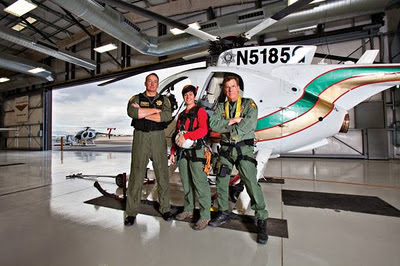Thanksgiving weekend is a very busy time of year for places like Red Rock Canyon, Mt. Charleston, Lake Mead, and other surrounding outdoor recreational areas. The more people that head outdoors to enjoy the 70 degree weather, the higher the potential is for rescues. This year was no exception as SAR Officers and Mountain Rescue volunteers participated in back-to-back (and sometimes simultaneous) rescues that spanned the entire Holiday weekend.
Over the course of the weekend, Rescuers responded to an ATV crash, a climber who had fallen 30 feet, and a hiker who had broken their leg. All victims were treated at the scene, extracted from their location, and delivered to waiting ambulances. Although each of these rescues were significant, the highlights of the weekend went to a 1,000ft technical rescue in Black Velvet Canyon and the rescue of 7 teenagers from rising waters near Goldstrike Canyon.
Black Velvet - Dream of Wild Turkeys Technical Rescue
On Sunday morning, November 27, at 0700 hours, we began a continuation of a rescue attempt from the previous night in Black Velvet Canyon where two females became stuck between the top of the 3rd pitch and above the 2nd pitch on Dream of Wild Turkeys (5.10a). They were located approximately 500 feet off of the valley floor and were stranded because their rope had lodged itself in a crack, making it unusable.
Pilots, Officers, and MR Volunteers attempted to access the victims on Saturday night, but due to winds, terrain, and other factors, the decision to leave them on a ledge/crack was ultimately made in order to complete the rescue in a safer and more efficient manner on Sunday. Before leaving for the night, one Officer was dropped off at the base of the cliff where voice contact was made with the climbers. It was confirmed that they were prepared to spend the remainder of the night in their current location.
On Sunday morning, Offers and Volunteers met at the parking lot located near Black Velvet where one SAR pilot met them with the Bell 500. At 0700, the team, along with gear, were flown to an area that was approximately 500 feet above the females. The ledge that the team worked from was the closest location to land since the wall was mostly vertical. A second team was placed at the base of the canyon to act as spotters and help the rescuer reach the climbers.
Once technical systems were set up, one rescuer was lowered to the females. Upon arrival, the rescuer assessed each climber and determined that both were medically sound. The rescuer was then lowered to the location of the rope. He was unable to free the rope, but was able to cut it in such a manner that a portion of it could still be used. The rescuer was then raised back to the climbers where he helped them rappell back down to the valley floor. As the climbers moved from one belay station to the next, the rescuer was lowered alongside each of them. Once all members had reached the ground, the officer and 2 climbers hiked out of the canyon.
Sauna Cave - Goldstrike Canyon Huey Extraction
On Sunday, November 27th at approximately 1830 hours, a call came in regarding 7 teenagers that were north of Gold Strike Canyon in Sauna Cave.
They were able to walk to the cave prior to the dam releasing water causing the river to rise and cover the area that they had walked.
After the water subsided, it was too dark for them to feel comfortable to walk back. Aside from being scared, one of the girls had fallen in the river and became cold causing her to not want to walk back.
One Officer and one volunteer flew from the hangar in the Huey. On their way to Goldstrike, they landed and picked up one Officer in Boulder City since it was faster for him to drive there than back to the hangar.
Once the rescue crew was on board, they flew to the Colorado River near the mouth of Gold Strike canyon using Night Vision Goggles (NVGs). The victims were located by flashlights that they had turned on.
Crews landed 100 yards downriver from them on a sandbar where one Officer and one volunteer were dropped off. After making their way to the victims and insuring that no one was injured, an extraction plan was put in place. The first group contained 4 victims while the second group consisted of 3. Although some of the members complained of being cold, all 7 victims were uninjured and safely extracted from the area.
Rescue crews weren't able to capture pictures on all of the rescues, but were able to snap some shots of the 1,000 ft. Black Velvet rescue.
This picture was taken from the ledge that the team worked from. The rescuer was lowered from this location to the stranded climbers.

The LZ for this rescue was very tight. Our Chief Pilot successfully deposited and extracted rescuers and gear from this location. The Officer seen in this photo is guiding the pilot into a one-skid landing.
This is a view of the edge. The volunteer in this photo was the edge-person who was responsible for all communication between the rescuer and system operation team.
This is a snapshot from the edge-person's point of view looking up towards technical operations. The team managing the main-line can be seen here. The team managing belay are located on the left side of the picture, just out of sight.
Four volunteers and two officers managed technical operations above the stranded hikers. Here's the team in all of their glory. The team was happy knowing that the climbers could be safely extracted, were able to survive the chilly evening on the rock, and walked away with no injuries.





























































.JPG)

